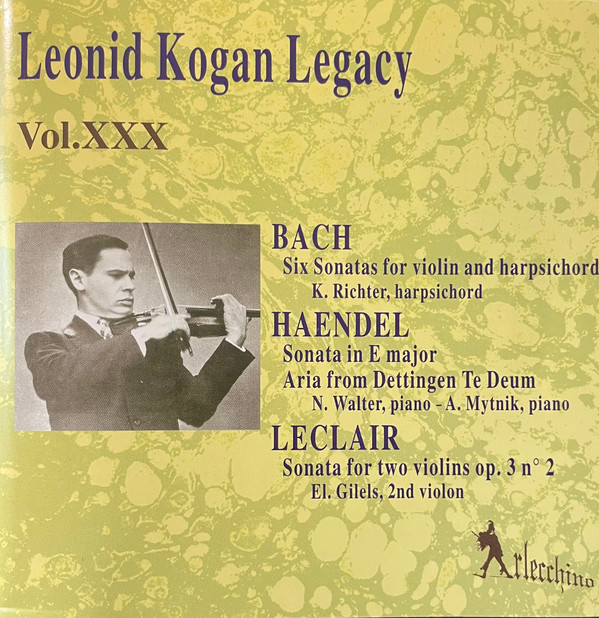Bach, Johann Sebastian / 3 Violin Sonatas (Yuri Liberzon, Guitar)
| Album: | 3 Violin Sonatas (Yuri Liberzon, Guitar) | Collection: | Classical | |
| Artist: | Bach, Johann Sebastian | Added: | Mar 2024 | |
| Label: | Audible Con Records | |||
A-File Activity
| Add Date: | 2024-03-04 | Pull Date: | 2024-05-06 | Charts: | Classical/Experimental |
|---|
| Week Ending: | Apr 28 | Mar 31 | Mar 24 | Mar 10 |
|---|---|---|---|---|
| Airplays: | 1 | 1 | 1 | 1 |
Recent Airplay
| 1. | Apr 27, 2024: | Music Casserole
Andante (5:07) |
3. | Mar 23, 2024: | Music Casserole
Fuga (10:13) |
|
| 2. | Mar 30, 2024: | Hopelessly Romantic
Sonata in C Major, BWV 1005. Adagio (3:54), Sonata in A Minor, BWV 1003. Grave (3:51) |
4. | Mar 06, 2024: | Exploring the ul-A file
Fuga (10:13) |
Album Review
Gary Lemco
Reviewed 2024-04-02
Reviewed 2024-04-02
Bach’s sonatas and partitas for solo violin (BWV 1001–1006) are
a set of six works from 1720 but published in 1802 by Nikolaus
Simrock in Bonn. The German violinist Joseph Joachim popularized
these works, and he made them available to Brahms, who made a
left-hand transcription of the famous Chaconne in D Minor. The set
consists of three sonatas da chiesa in four movements and three
partitas in dance-form movements. These guitar versions were made
by Manuel Barrueco, the teacher of the performer, Yuri Liberzon.
The Sonata No. 1 in G Minor begins with a stately Adagio, meditative
and florid. The Fuga is set in several, simultaneous voices, typical of
Bach’s fondness for the procedure. The Siciliana is a courtly Italian
dance, quite lyrical and graceful. The Presto is a brilliant study in rapid
motion, challenge to finger and articulate without smearing the lines.
The Sonata No. 2 in A Minor opens with a somber Grave movement,
a processional with drooping, ornamental figures. The Fuga is quite
extended, a challenge to maintain in its polyphonic tension. The third
movement Andante returns to a dignified, stately manner, cautiously
funereal in temperament. The mood becomes more animated and
dynamic in the closing Allegro, whose rapid figurations seem to shift
and compete with one another.
The Sonata in C Major’s first movement, Adagio, conveys a dark
character almost at odds with its key signature, a kind of sarabande
in Spanish style. The Fuga that follows is among the lengthiest in
solo Bach works, difficult to sustain its contrapuntal lines. A sweet
Largo is next, a mournful, intimate song. The last movement, Allegro
assai, moves briskly a study in quick, repeated notes and wide intervals.
a set of six works from 1720 but published in 1802 by Nikolaus
Simrock in Bonn. The German violinist Joseph Joachim popularized
these works, and he made them available to Brahms, who made a
left-hand transcription of the famous Chaconne in D Minor. The set
consists of three sonatas da chiesa in four movements and three
partitas in dance-form movements. These guitar versions were made
by Manuel Barrueco, the teacher of the performer, Yuri Liberzon.
The Sonata No. 1 in G Minor begins with a stately Adagio, meditative
and florid. The Fuga is set in several, simultaneous voices, typical of
Bach’s fondness for the procedure. The Siciliana is a courtly Italian
dance, quite lyrical and graceful. The Presto is a brilliant study in rapid
motion, challenge to finger and articulate without smearing the lines.
The Sonata No. 2 in A Minor opens with a somber Grave movement,
a processional with drooping, ornamental figures. The Fuga is quite
extended, a challenge to maintain in its polyphonic tension. The third
movement Andante returns to a dignified, stately manner, cautiously
funereal in temperament. The mood becomes more animated and
dynamic in the closing Allegro, whose rapid figurations seem to shift
and compete with one another.
The Sonata in C Major’s first movement, Adagio, conveys a dark
character almost at odds with its key signature, a kind of sarabande
in Spanish style. The Fuga that follows is among the lengthiest in
solo Bach works, difficult to sustain its contrapuntal lines. A sweet
Largo is next, a mournful, intimate song. The last movement, Allegro
assai, moves briskly a study in quick, repeated notes and wide intervals.
Track Listing
